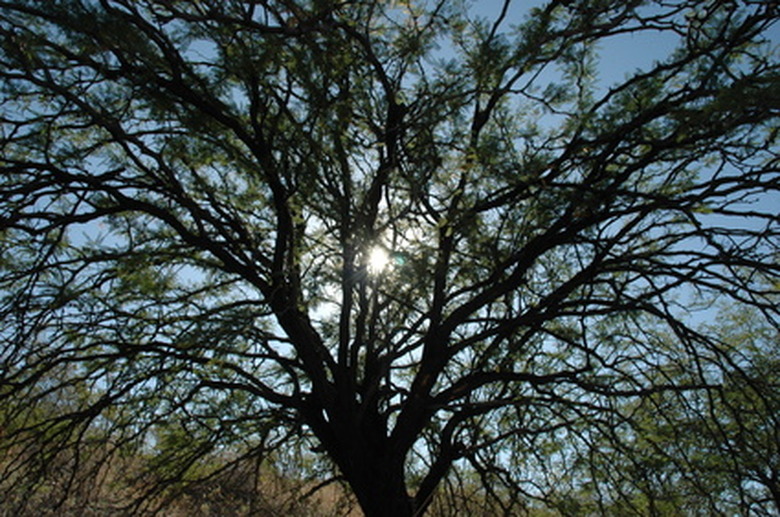Palo Verde Tree Facts
Palo verde means "green stick" in Spanish; all parts of the these woody legumes are green: their trunks, branches and leaves. These large shrubs or small trees offer spectacular displays of yellow blossoms. Along with saguaro cacti, they are popularly featured in art depicting the Sonora Desert. The palo verde is the state tree of Arizona.
Description
Palo verde trees have dense, twiggy, low-hanging branches. Four to six major stems usually sprout from the main trunk about 8 inches from the ground. The crowns are ordinarily 12 to 18 feet wide, depending on the variety. Palo verdes have smooth, greenish bark that contains chlorophyll and conducts photosynthesis.
- Palo verde means "green stick" in Spanish; all parts of the these woody legumes are green: their trunks, branches and leaves.
- Along with saguaro cacti, they are popularly featured in art depicting the Sonora Desert.
Palo verdes are branch deciduous; they shed some of their branches during severe drought. Their deep root systems can store water during drought. They have small leaves, about 1 inch long; this small size prevents the loss of water through transpiration and evaporation from leaf pores. When rainfall returns, new branches and leaves will grow back. They flower in the late spring if there is rainfall.
Species of Palo Verde
There are four varieties of palo verde tree of genus Parkinsonia, formerly called Cercidium; that name is still used in some sources.
Blue palo verde (Parkinsonia floridum) has a wide, spreading crown and grows upright as high as 30 feet. It frequently lines the streets and public areas in Tucson and Phoenix.
- Palo verdes are branch deciduous; they shed some of their branches during severe drought.
Foothills palo verde (Parkinsonia microphyllum) is slow growing and shrubbier than other palo verdes, reaching about 20 feet tall with spiny branches. Its bark is yellowish-green.
Sonoran palo verde (Parkinsonia praecox) is taller than the other palo verde trees and has fewer lower branches. It grows as high as 35 feet. It is also called green stick, littleleaf palo verde and yellow palo verde.
Mexican palo verde (Parkinsonia aculeate), also called luvia de oro, Spanish for "golden rain," is a rapidly growing variety of palo verde. Luvia de oro is a reference to its profusion of yellow blossoms. It reseeds easily and spreads aggressively.
- Foothills palo verde (Parkinsonia microphyllum) is slow growing and shrubbier than other palo verdes, reaching about 20 feet tall with spiny branches.
Habitat
Palo verde trees are the dominant species of upland areas of the Sonoran Desert. They grow on alluvial outwash plains and mountain slopes at altitudes from 1,000 to 4,000 feet. They are a favorite shelter of hummingbirds, doves and other desert birds and animals.
Uses
Native Americans and indigenous people of northern Mexico have ground the seeds to make a flour. They have made a red dye from the flowers and necklaces from the seeds. They used the wood for fires and cooking.
Protects Saguaro Cacti
The canopy of palo verde trees often protect young saguaro cacti, the large, branching cacti of the Sonoran Desert, shading them in the summer and helping keep them warm in the winter. The slow-growing saguaro cacti eventually replace the palo verde trees that sheltered them.
- Palo verde trees are the dominant species of upland areas of the Sonoran Desert.
- The canopy of palo verde trees often protect young saguaro cacti, the large, branching cacti of the Sonoran Desert, shading them in the summer and helping keep them warm in the winter.
